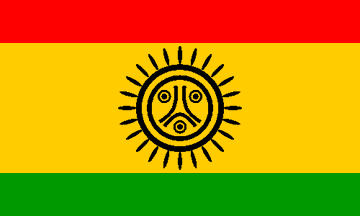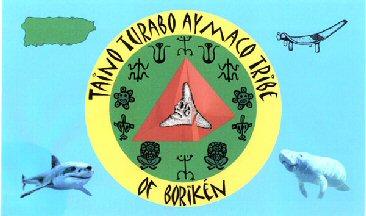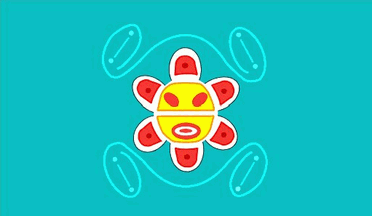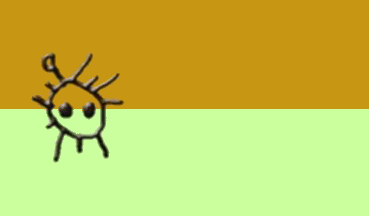 image by Antonio Martins (based on an original by Jorge
Ramos), 3 August 2004
image by Antonio Martins (based on an original by Jorge
Ramos), 3 August 2004
Last modified: 2021-12-18 by rob raeside
Keywords: puerto rico | dominican republic | puerto rico | taino |
Links: FOTW homepage |
search |
disclaimer and copyright |
write us |
mirrors
 image by Antonio Martins (based on an original by Jorge
Ramos), 3 August 2004
image by Antonio Martins (based on an original by Jorge
Ramos), 3 August 2004
See also:
Chief Torres and I just finished editing the write-up for the new Taino tribe flag. The image is on the following website, www.taino-tribe.org. Here is the fascinating story behind the flag:
Taino Tribal Nation of Borikén (Puerto Rico) by Cacike Pedro Guanikeyu Torres, Principal Chief (as told to Peter Orenski)
The Jatibonicu Taino of Puerto Rico (Puerto Rico is
"Borikén" in the Taino language means "Land of
the Valiant and Noble Lord", that refers also to the Great
Spirit or Creator) are descendants of the original 24 tribal
bands that settled in Puerto Rico. Their ancestors are the
Central American Indians and the Arawak Indians of South America,
who had migrated north in the early centuries of the second
millennium and colonized the islands of the Caribbean where
Tainos can be found today in Puerto Rico, Santo Domingo/Haiti,
Jamaica, Cuba, the Bahamas and Florida (some 15 bands are in
Florida) (see: Jatibonicu Taino of New Jersey).
Jatibonicu means "The Great People of the Sacred High
Waters" (waterfalls), whereas "Taino" is a
name first used by the Spanish invaders. It derives from
the answer tribesmen gave the Spanish when the latter asked the
Jatibonicu people, "Who are you?" The Natives simply
answered "Taino" – meaning "Good and Noble
People" – in order to distinguish themselves from
some of the more warlike southeastern tribes, such as the feared
Caribs or Waib.
The first contact with Europeans – which signaled, as it
later did for other Native Americans throughout the Hemisphere,
the beginning of the end for an estimated 3-8 million Tainos who
had spread throughout the Caribbean islands and Florida –
was on October 12, 1492, when Columbus landed on the island of
Guanahani (today, San Salvador in the Bahamas). He later departed
for Spain with onboard six Borikén Taino women and one
13-year-old boy named of Gueycan (Center of the Sun), whom
happenstance had placed in San Salvador, and whom Columbus
paraded before the royal court of Ferdinand and Isabella in
Spain.
When Columbus returned on his second voyage in 1493, he
brought the six women and the young Taino boy with him. On seeing
the outlines of Puerto Rico on November 18th, 1493, the
overjoyed women shouted "Borikén" and jumped overboard
and swam for shore. On the 19th day of November, a Sunday
morning, Columbus and his men landed on the shores of the island
of Borikén (today, Puerto Rico).
The flag of the Jatibonicu Taino Tribal Nation of Borikén
(Tribal motto "Like A Mountain We Stand Alone") derives
from the prophecy of a Great Three-Colored Rainbow and a later
vision, which a Jatibonicu Tribal Elder had in the late 60's
while he stood in the ceremonial center during a vision quest in
Caguana (named after the Fertility Mother of the Taino tribes),
in Puerto Rico. The vision contained all the elements currently
shown in the central charge of the flag, and it also contained a
field of yellow. The green and red were added later, red standing
for tribal blood spilled during the tragic years following
European contact, as reflected by "maga", a red flower
indigenous to the region. Green signifies Bibi Atabey or Mother
Earth. Yellow is for Baba Guey (Father Sun) and indicates the
reflection of the rays of the sun – a symbol of great
illumination and wisdom – upon the wings of the
Colibri, the hummingbird that is the totem of the Jatibonicu
Taino tribe.
Relative stripe ratios and detailed specifications for the
central charge were worked out during March and April 2001 by
Chief Guanikeyu (Noble Bird of the White Earth) Torres, whom the
author assisted with computer graphics. The outer ring of the
central charge symbolizes the men's sun circle, and hence Baba
Guey, while the inner circle is the women's moon circle, or
Atabeira, Grandmother Moon. The outer ring is surrounded by 24
leaves of the sacred Cohobana Tree, the seeds of which are
essential for tribal sacred ceremonies. The number of leaves
stand for the Nation's 24 original clans or tribal bands in
Puerto Rico.
Contrary to first impression, the elements inside the moon circle
do not represent a human face, just as the outer leaves do no
represent sun rays. Rather, the three circled dots inside the
moon circle are a reflection on water of the Sacred Mountain
(note Tribal motto) – hence the top of the mountain
appears at the bottom in the reflection. The three elements that
denote the Sacred Mountain symbolize three Spirits. Yaya, at the
summit, is the Spirit of Spirits, or Great Spirit, or Creator.
The left circled dot, from the viewer's perspective, symbolizes
the Spirit of the Living World, or Goiz, while the circled dot on
the right is the Spirit of the Ancestors, or Upia. It is
important to avoid calling Upia "spirit of the
dead" because the Jatibonicu Taino people do not
believe in death. The curved lines of the central symbol of
the charge symbolize the sacred Snuff Pipe in which crushed seeds
from the Cohobana Tree are snuffed during sacred Cohoba visionary
ceremonies.
The motto of the new flag is "One People, One Nation, One
Destiny" because the flag also represents the three
confederated Taino tribal bands in Puerto Rico (The Jatibonicu
Taino Tribe of Borikén), Florida (The Tekesta Taino Tribal
Band of Bimini Florida), and New Jersey (Jatibonicu Taino Tribal
Band of New Jersey). These three confederated Taino tribal bands
form the central Grand Council of the Government of The
Jatibonicu Taino Tribal Nation.
The flag dimensions are 3:5 and spot colors are Pantone 347
green; Pantone 485 red; Pantone 116 yellow, and black . When
using nylon bunting in appliqué work, Irish green, Canada Red,
and Daffodil yellow are recommended in Glaser Mills' color card
for DuPont Type 66 bright nylon.
Peter Orenski, 4 June 2001
Puerto Ricans are said to genetically comprise Spanish, Afican
and Taíno bloods. The original population of Taínos were
largely exterminated in Puerto Rico a long time ago, in part do
to Spaniard maltreatment, new diseases brought to the island, as
chickenpox and siphyllis, war, and expratiation. Notwithstanding
this, it is recognized that there are some fellow Puerto Ricans
that still carries with them visible Taíno features, specially
in the face, hair and, most prominently, maxillary and mandibular
architecture. We are very proud of our Taíno heritage. It is
very pervasive in our language and in the name of rivers,
mountains and cities.
Blas Delgado Ortiz , 7 June 2001
Our tribal flag can be associated with the municipalities of Orocovis, Barranquitas,
and Aibonito in Puerto Rico. The
Jatibonicu Taino is the local tribe for all three towns.
These towns are located within our tribal territory.
Peter Torres, 26 March 2002
I Contacted the Quisqueya Foundation (Dominican Republic's
Taíno) and the informed me that the are using the same flag as
above.
Raven O'neal, 7 August 2005
 image from www.indio.net/aymaco,
located by Valentin Poposki, 4 April 2006
image from www.indio.net/aymaco,
located by Valentin Poposki, 4 April 2006
It seemed to me that one flag was designed to represent the entire Boriken
Taino nation and the second to represent a particular tribe of that nation.
Reinforcing that impression is a map of the locations of the various Taino
tribes of Puerto Rico which can be seen at www.uctp.org.
You can see that the Aymaco is presented as the tribe living in
the northwest corner of the island.
Ned Smith, 4 April 2006
There is a flag of the Baramaya Taino
flag that can be seen at www.starworksentertainment.com.
The Baramaya "tribe" appears to represent a smaller unit than those shown on the
map at www.uctp.org. A map showing the island
divided into such smaller units can be seen at web.archive.org.
The Baramaya are located near the center of the south coast.
Ned Smith, 4 April 2006
There is one more band of Taino Nation - Maisiti Yukayeke of
the Taino Tribe. And there is a flag
(?) shown on their website, which is defunct now, but can be reached at web.archive.org.
It seems there are several bands or clans of Taino Nation in
Puerto Rico, but they are not recognized by the authorities as
separate entities.
Valentin Poposki, 5 April 2006
Yukayeke Guajataka Taino community website mypeoplepc.com/members/tekina1/Guajataka,
shows an image which might
be their flag.
Valentin Poposki, 5 April 2006

image by Chrystian Kretowicz, 3 October 2009
One more organization is called "Taino Nation of the
Antilles", which seems to be stationed in New York. You can
see the flag here at nacion_taina.tripod.com.
Valentin Poposki, 5 April 2006
It is supposed to be the flag of the Taino Nation of the
Antilles, restored in 1992.
Chrystian Kretowicz, 3 October 2009
Better photo at api.ning.com.
According the photo, the red in the tortoise seems to be in fact
orange, and the very light blue above and below seems to be light
green.
Jaume Ollé, 3 October 2009
 image by Carlalynne Yarey Melendez, 18 July 2012
image by Carlalynne Yarey Melendez, 18 July 2012
Liga Guakia Taina ke (Our
Taino Land League, Inc.) is writing to request that our flag be placed on your
website. Our mission is creation of the Naguake Community east-central Boriken
(Puerto Rico). The community consists of 3,000 acres of land running from the
base of Punta Yegua in the east to the Sierra of Cayey in the west. This land
once held a thriving, sustainable indigenous population and as such is rich in
historical resources including numerous significant archaeological and cultural
sites. We are currently requesting the State-Federal governments to set aside
and designate our region as an EcoAgroCultural Reserve for the purpose of
protecting our ecological, agricultural and cultural resources.
I have included our flag in the attachment. Please visit our web site to learn
about us and our community.
Carlalynne Yarey Melendez, 18 July 2012




